Olympus SZX16 User Manual

Modules described in this manual
SZX16
SZX-R/SZH-P400/SZH-P600
SZX-2-2RE16
SZX-STAD1
SZX2-AN
SZX-PO
SZX-STAD2
SZH-STAD1 INSTRUCTIONS
SZX16
RESEARCH HIGH-CLASS STEREO MICROSCOPE
This instruction manual is for the Olympus SZX16 Research High-Class Stereo Microscope System. To ensure the safety, obtain optimum performance and to familiarize yourself full with the use of this microscope, we recommend that you study this manual thoroughly before operating the microscope.
Retain this instruction manual in an easily accessible place near the work desk for future reference.
A X 7 5 0 0

This device complies with the requirements of directive 98/79/EC concerning in vitro diagnostic medical devices. CE marking means the conformity to the directive.
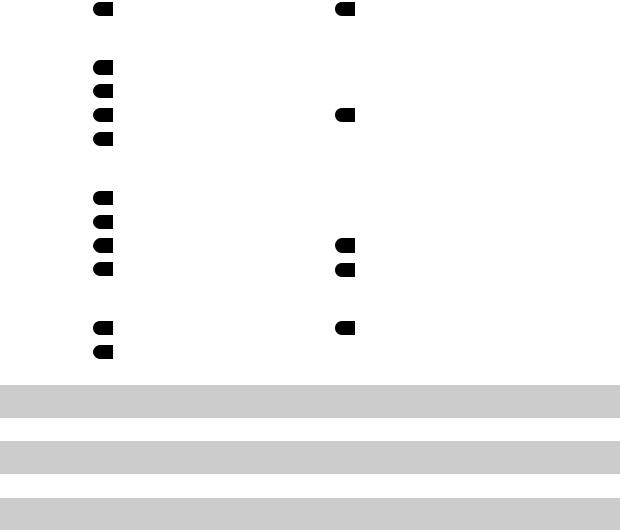
|
|
|
|
|
|
|
SZX16 |
|
|
CONTENTS |
|
|
|
|
|||
|
|
|
|
|||||
|
IMPORTANT — Be sure to read this section for safe use of the equipment. — |
1-3 |
|
|||||
|
|
|
|
|
|
|
||
|
|
|
|
|
|
|
|
|
|
1 |
NOMENCLATURE |
|
|
4 |
|
||
|
|
|
|
|
|
|
||
|
|
|
|
|
|
|||
|
2 |
CONTROLS |
|
|
5 |
|
||
|
|
|
|
|||||
|
|
|
|
|||||
|
3 SUMMARY OF OBSERVATION PROCEDURE |
6 |
|
|||||
|
|
|
|
|
|
|
||
|
|
|
|
|
|
|||
|
4 |
USING THE CONTROLS |
|
|
7-13 |
|
||
|
|
|
|
|
|
|
|
|
|
|
4-1 |
Base...................................................................................................................................................................................................................... |
|
|
7 |
|
|
|
|
|
1 |
Using the Stage Plate |
2 |
Placing the Specimen |
|
|
|
|
4-2 |
Microscope Body and Focusing Assembly ......................................................................................... |
7-9 |
|
|||
|
|
|
1 |
Adjusting the Tension of the Coarse Focus Adjustment Knob |
|
|
||
|
|
|
2 |
Engaging and Disengaging the Zooming Knob Click Stop Function |
|
|
||
|
|
|
3 |
Adjusting the Aperture Iris Diaphragm |
4 |
Zoom Magnification Indication |
|
|
|
|
|
5 |
2X Objective Correction Collar |
|
|
|
|
|
|
4-3 |
Observation Tube............................................................................................................................... |
|
................................... |
10-12 |
|
|
|
|
|
1 |
Adjusting the Interpupillary Distance |
|
|
|
|
|
|
|
2 |
Adjusting the Diopter (Zoom Parfocal Adjustment) |
|
|
||
|
|
|
3 |
Using the Eye Shades |
4 |
Using the Eyepiece Micrometer Disk |
|
|
|
|
|
5 |
Selecting the Light Path |
6 |
Adjusting the Tilt |
|
|
|
|
4-4 |
TV Observation and Photomicrography |
........................................................................................................ |
13 |
|
||
|
|
|
1 |
Selecting the TV Adapter Magnification |
2 |
Mounting the TV Adapter |
|
|
|
|
|
3 |
Selecting the TV Camera Light Path |
|
|
|
|
5TROUBLESHOOTING GUIDE
6SPECIFICATIONS
7OBSERVATION MAGNIFICATIONS AND OBSERVATION AREAS
14
15,16
17
|
|
|
|
|
|
|
|
|
|
|
8 |
ASSEMBLY |
18-21 |
|
|
|
|
|
|
|
|
|
|
|
|
9 |
OPERATION OF OTHER MODULES |
22-30 |
|
|
|
|
|
|
|
|
9-1 |
Drop Prevention Collar SZX-R and Auxiliary Pillar SZH-P400/SZH-P600 |
........ 22 |
|
|
9-2 |
Revolving Nosepiece SZX2-2RE16.......................................................................................................... |
23-25 |
|
|
9-3 |
BX Stage Adapter Type 1 SZX-STAD1 ................................................................................................. |
26-28 |
|
|
9-4 |
BX Stage Adapter Type 2 SZX-STAD2 ................................................................................................. |
29-30 |
|
|
9-5 |
Stage Adapter Type 1 SZH-STAD1 ...................................................................................................................... |
30 |
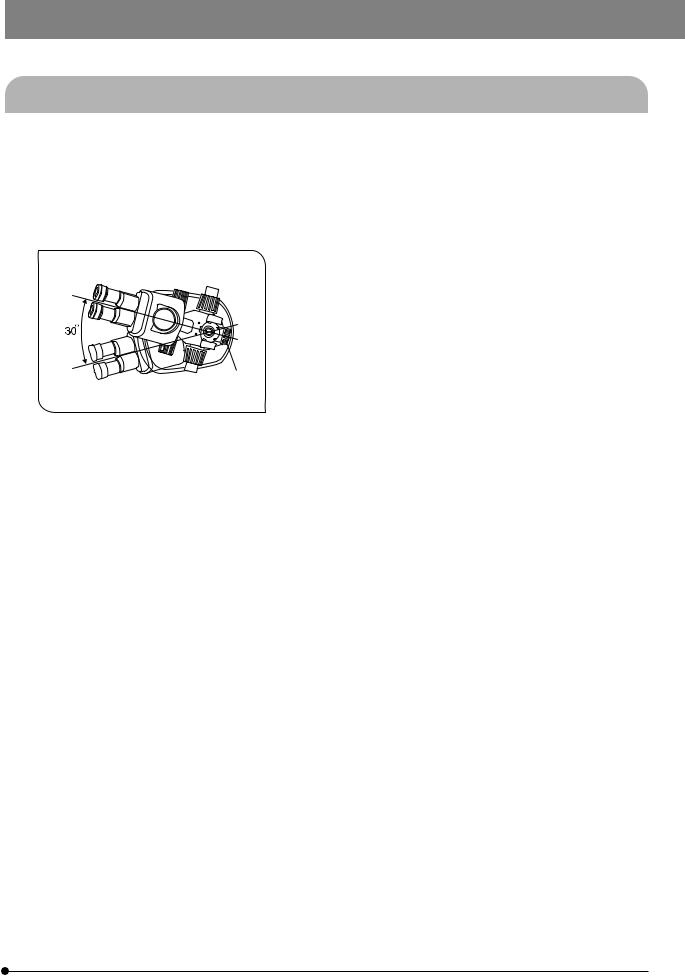
SZX16
IMPORTANT
 SAFETY PRECAUTIONS
SAFETY PRECAUTIONS
1.After the equipment has been used in an observation of a specimen that is accompanied with a potential of infection, clean the parts coming in contact with the specimen to prevent infection.
·Moving this microscope is accompanied with the risk of dropping the specimen and causing infections. Be sure to remove the specimen before moving this product.
·In case the specimen is damaged by erroneous operation, promptly take the infection prevention measures.
·The microscope may become unstable when certain intermediate attachments and/or photography unit are mounted on it. Take the measures so that the microscope does not turn over.
2.To prevent the microscope body from turning over, its left-right pivot angle must be limited to 30° as shown in Fig. 1. The tilt of the desktop surface
should be no more than 5°.
3. Sufficient care is required during observation with a low-magnification objective, because the objective’s long WD (Working Distance) can
|
|
displace the microscope body to a higher position. |
|
|
The measures for prevention of turning over are also required when using |
|
@ |
an auxiliary pillar (SZH-P400/P600), because this also makes the |
|
microscope body to be displaced to a higher position. |
|
|
|
|
|
|
4. To adjust the microscope body height, be sure to hold the microscope |
Fig. 1 |
|
body with one hand while loosening the focusing assembly clamping |
|
knob @. (Fig. 1) |
|
|
|
|
|
|
(Use the drop prevention collar (SZX-R) to prevent a hazard from occurring.) |
|
|
Be careful not to pinch your finger during the adjustment. |
1
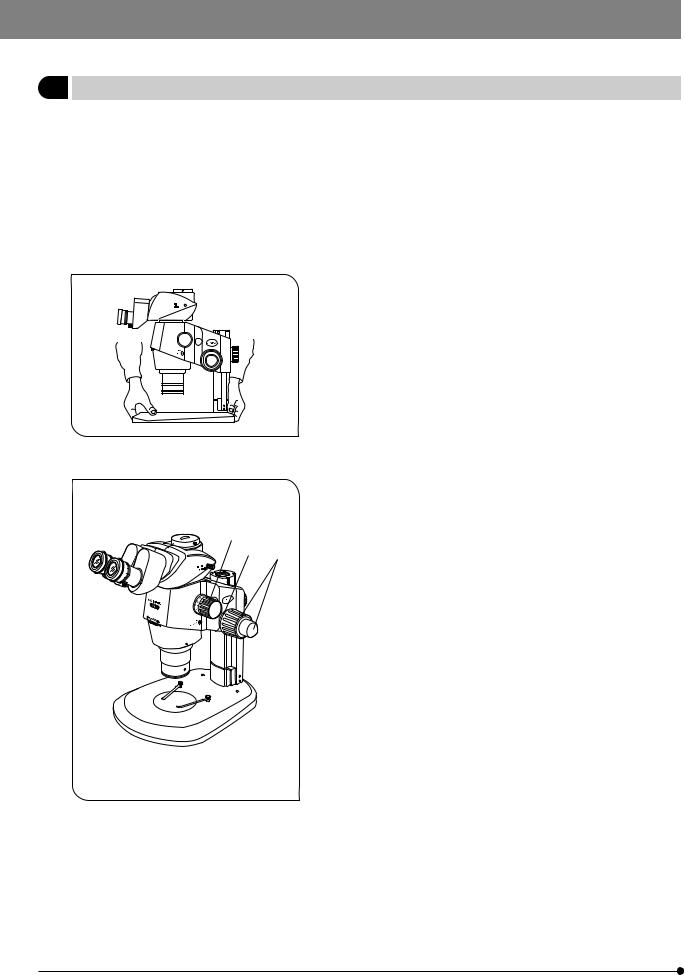
1Getting Ready
Fig. 2
²
³ @
Fig. 3
1.A microscope is a precision instrument. Handle it with care and avoid subjecting it to sudden or severe impact.
2.Do not use the microscope where it is subjected to direct sunlight, high temperature and humidity, or vibration. (For the operating environment, see Chapter 6, “SPECIFICATIONS” on page 16.)
3.When moving the microscope, remove the specimen in advance. Then, hold the front part of the base with one hand and hold the rear part of the base with the other hand to avoid tilting the microscope.
Also remove any module or attachment from the microscope to minimize the weight before moving.
4.Observe the following cautions when operating the coarse focus adjustment knob or the zooming knob.
Operation |
Manipulated Controls |
|
Caution |
|
|
|
|
Focusing |
Coarse/fine focus |
1. |
If the knob hits the upper or lower |
|
adjustment knobs @ |
|
limiting mechanism violently or |
|
(Fig. 3) |
|
it is rotated after it hits a limiting |
|
|
|
mechanism, the internal |
|
|
|
mechanism may be damaged. |
|
|
|
|
|
|
2. |
If the knobs on the left and right |
|
|
|
are rotated in opposite directions, |
|
|
|
the internal mechanism will be |
|
|
|
damaged. (The rotation tension |
|
|
|
of the coarse focus adjustment |
|
|
|
knob should be adjusted using |
|
|
|
the rotation tension adjustment |
|
|
|
ring ³ on the knob.) |
|
|
|
|
Zooming |
Zooming knob ² |
1. |
If the knob hits the upper or lower |
|
(Fig. 3) |
|
limiting mechanism violently or |
|
|
|
it is rotated after it hits a limiting |
|
|
|
mechanism, the internal |
|
|
|
mechanism may be damaged. |
|
|
|
|
|
|
2. |
If the knobs on the left and right |
|
|
|
are rotated in opposite directions, |
|
|
|
the internal mechanism will be |
|
|
|
damaged. |
|
|
|
|
5.Only one intermediate attachment can basically be used, but two attachments may also be used though the peripheral part of the image may be obscured.
For the coaxial vertical illuminator (SZX2-ILLC16) and reflected fluorescent light illuminator (SZX2-RFA16), only either can be attached because they
must always be attached at the lowest position.
}The SZX2-ILLC16 is not considered to be an attachment. Therefore, the SZX2-LBS can be mounted above it without any restriction.
2

SZX16
2Maintenance and Storage
1.To clean the lenses and other glass components, simply blow dirty away using a commercially available blower and wipe gently using a piece of cleaning paper (or clean gauze).
If a lens is stained with fingerprints or oil smudges, wipe it gauze slightly moistened with commercially available absolute alcohol.
 Since the absolute alcohol is highly flammable, it must be handled carefully.
Since the absolute alcohol is highly flammable, it must be handled carefully.
Be sure to keep it away from open flames or potential sources of electrical sparks -- for example, electrical equipment that is being switched on or off.
Also remember to always use it only in a well-ventilated room.
2.The equipment uses plastic resins extensively in its external finish. Do not attempt to use organic solvents to clean them but simply wipe them using a lint-free, soft cloth. To clean an extremely dirty part, use a soft cloth lightly moistened with a diluted neutral detergent.
3.Never disassemble any part of the microscope as this could result in malfunctions or reduced performance.
4.When not using the microscope, keep it covered with the dust cover provided. If a module containing a source of heat is mounted on the microscope, wait until it has cooled down before covering.
5.This equipment should be disposed of by following the rules and regulations of your national or local government.
3Caution
If the microscope is used in a manner not specified by this manual, the safety of the user may be imperiled. In addition, the microscope may also be damaged. Always use the microscope as outlined in this instruction manual.
The following symbols are used to set off text in this instruction manual.
 : Indicates that failure to follow the instructions in the warning could result in bodily harm to the user and/or damage to equipment (including objects in the vicinity of the equipment).
: Indicates that failure to follow the instructions in the warning could result in bodily harm to the user and/or damage to equipment (including objects in the vicinity of the equipment).
# : Indicates that failure to follow the instructions could result in damage to equipment. } : Indicates commentary (for ease of operation and maintenance).
4Intended use
This instrument has been designed to be used to observe magnified images of specimens in routine and research applications.
Do not use this instrument for any purpose other than its intended use.
3
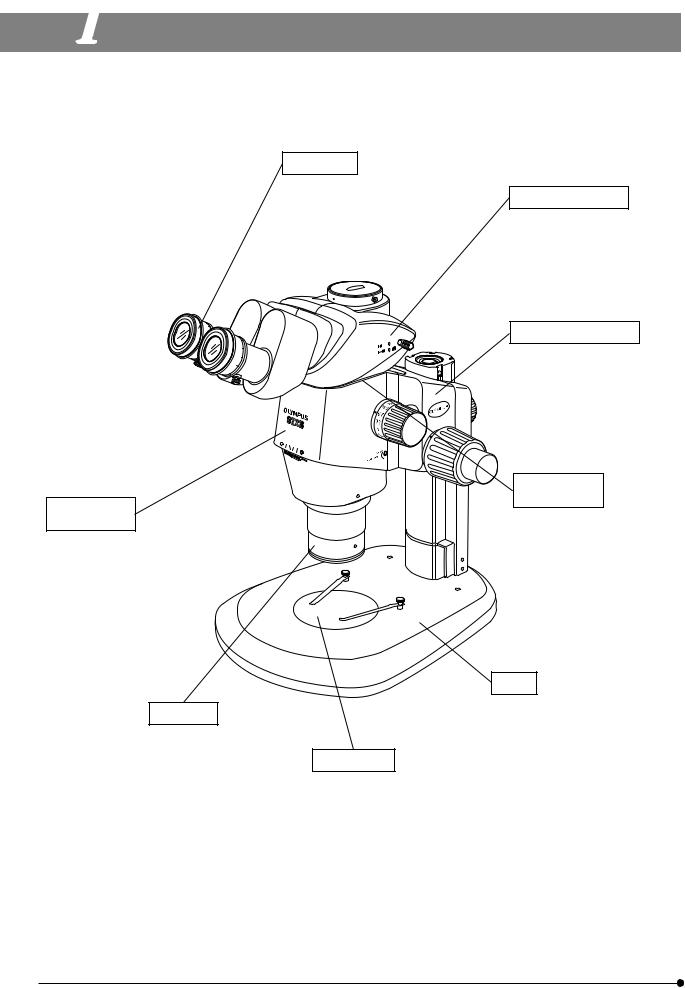
1 NOMENCLATURE
}The following illustration shows a typical system composed of modules marked with “{” in the list of each module, and other modules may also be used in place of them. For the modules that are not shown in the module lists below, please contact Olympus or the latest catalogues.
Microscope body
{16X zoom microscope body: SZX2-ZB16
Objective
· SDFPLFL0.3X** · SDFPLAPO0.5XPF · SDFPLAPO0.8X {SDFPLAPO1XPF · SDFPLAPO1.6XPF · SDFPLAPO2XPFC
Eyepieces
{WHN10X-H
·WHSZ15X-H
·WHSZ20X-H
·WHSZ30X-H
Stage plate
Observation tube
{Trinocular observation tube: SZX2-TR30/TR30PT
·Tilting trinocular observation tube: SZX2-TTR/TTRPT
Focusing assembly
·Coarse/fine focusing assembly: SZX2-FOF
·Focusing assembly: SZX2-FO {Coarse/fine focusing assembly for heavy load: SZX2-FOFH
·Motorized focusing assembly: SZX2-FOA2
Intermediate attachments
·Coaxial vertical illuminator: SZX2-ILLC16*
·Beam splitter: SZX2-LBS*
·Vertical fluorescent light illuminator: SZX2-RFA16*
Base
{Standard base: SZX2-ST**
·Large base: SZX2-STL
·Transmitted light base: SZX2-ILLB*
SZX2-ILLD*
SZX2-ILLK*
SZX2-ILLT*
{Monochrome plate: SZ2-SPBW/SP-BW2
·Glass plate: SP-C
·Fluorescence center plate: SP-FL
*A separate instruction manual is available for the module marked *.
**The standard base (SZX2-ST) requires use of the optional auxiliary pillar (SZH-P400) and optional drop prevention collar (SZX-R). The large base (SZX2-STL) comes with the auxiliary pillar (SZH-P400) mounted as standard. This enables the large base to be used as is. However, be sure to use the drop prevention collar (SZX-R) in combination.
4
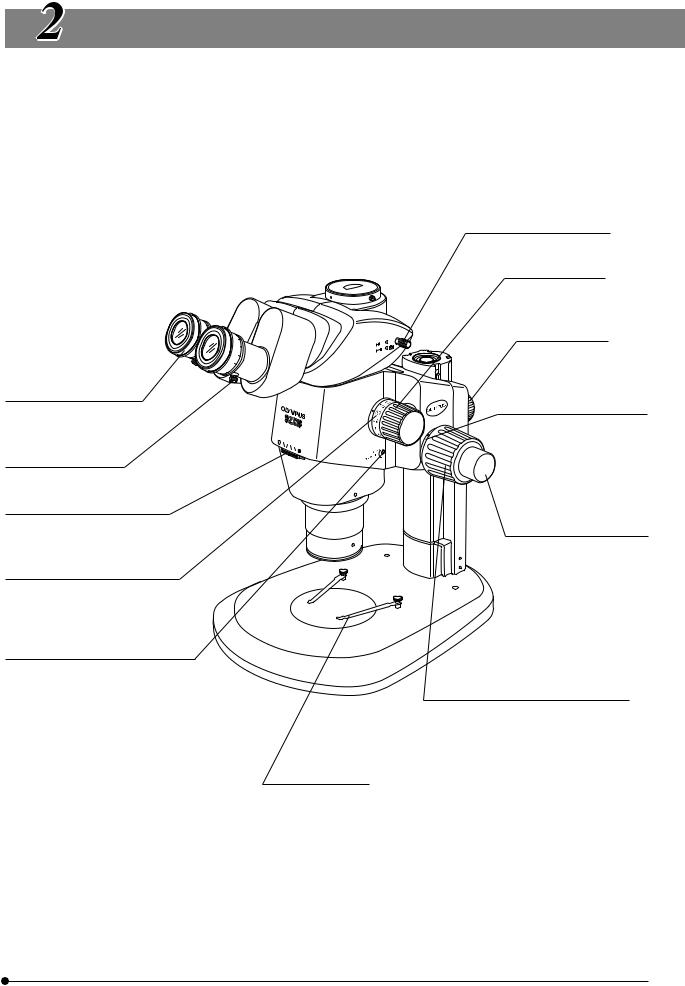
SZX16
CONTROLS
}If the microscope is not yet assembled, see Chapter 8, “ASSEMBLY” (pages 18 to 21) before the following.
Diopter adjustment ring (P.10)
±5m-1 (per meter)
Eyepiece clamping knob
Aperture iris diaphragm ring (P. 8)
Zoom magnification indication (P. 9) 0.7 to 11.5 (14 indications)
Light path selector knob (P. 12)
Zooming knob
0.7X to 11.5X
Focusing assembly clamping knob
Coarse focus adjustment knob tension adjustment ring (P. 7)
Fine focus adjustment knob (SZX2-FOF/FOFH)
Stroke: 80 mm
Stroke per turn: 0.77 mm
Click stop ON-OFF screw (P. 8)
Engages or disengages the click stop function for each zoom magnification.
Coarse focus adjustment knob
Total Stroke: 80 mm
Stroke per turn (SZX2-FOF/FOFH): 36.8 mm
Stroke per turn (SZX2-FO): 21 mm
Specimen holder
Locks the specimen.
5
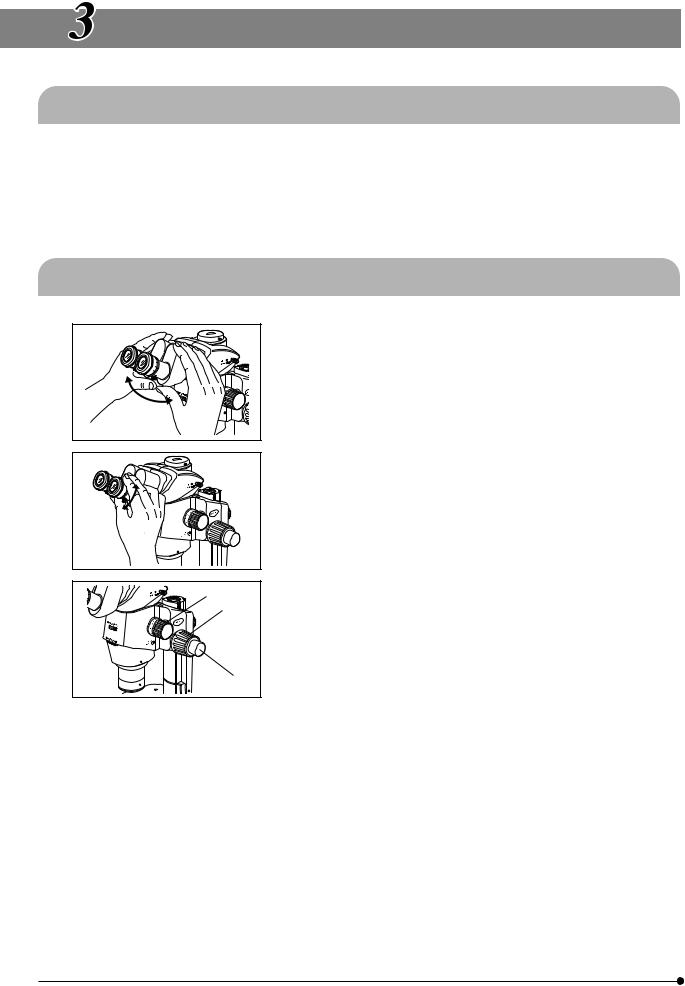
SUMMARY OF OBSERVATION PROCEDURE
3-1 Preparation
|
|
Ref. Page |
1. |
Check and tighten the connection of each component, especially the observation tube................................................... |
(Page 20) |
2. |
Check that the angled formed by the microscope body with respect to the base is less than the |
|
|
turning-over prevention angle.................................................................................................................................................................................................................................. |
(Page 19) |
3. |
Adjust the tension of the coarse focus adjustment knob. .................................................................................................................................................. |
(Page 7) |
4. |
Confirm the correct settings. |
|
3-2 Observation Procedure
@
²
³
1.Place a specimen on the stage. (Page 7)
2.Adjust the interpupillary distance. (Page 10)
3.Make diopter adjustment of the eyepieces. (Page 10)
(The adjustment procedure is variable depending on whether the eyepiece micrometer disk is used or not.)
4.Set the zooming knob @ to the lowest zoom magnification and bring the microscope into focus by rotating the coarse focus adjustment knob ².
5.Rotate the zooming knob @ to the desired magnification and precisely focus the microscope on the specimen with the coarse focus adjustment knob ² and fine focus adjustment knob ³ (the fine focus adjustment knob is not provided with the SZX2-FO).
}The contrast of the observed image and the focal depth of the specimen can be adjusted with the aperture iris diaphragm ring.
6
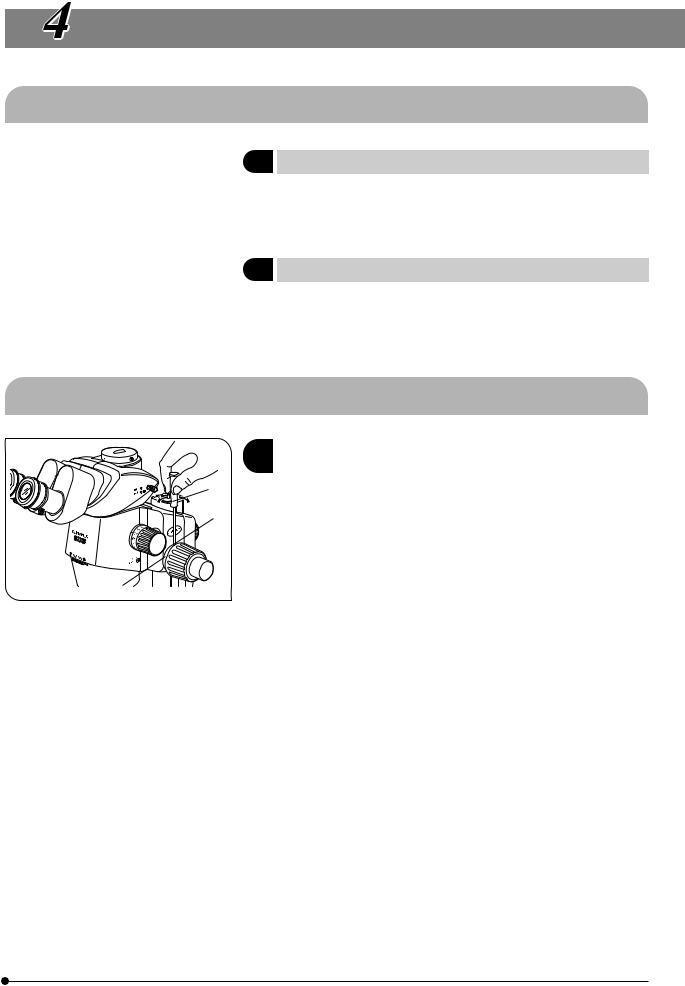
SZX16
USING THE CONTROLS
4-1 Base
1Using the Stage Plate
In reflected light observation, the stage plate can be placed either the white or black side facing up.
#Win transmitted light observation, use the transparent glass stage plate (SP-C).
2Placing the Specimen
1.Place the specimen on the approximate center of the stage plate. Hold the specimen with the specimen holder as required.
2.Illuminate the specimen with an illuminator selected according to the specimen under observation.
4-2 Microscope Body and Focusing Assembly
@
Fig. 4
1 |
Adjusting the Tension of the Coarse |
(Fig. 4) |
|
Focus Adjustment Knob |
|||
|
|||
³ |
}This operation is intended to facilitate the rotation of the knobs while |
||
|
preventing the spontaneous drop of the microscope body. It is |
||
²recommended to set the knob tension to a slightly higher level than the
point where spontaneous drop occurs.
If the knobs are hard to move because of the weight of option modules and/or TV camera mounted on the microscope body, it is recommended to use the focusing assembly for heavy load (SZX2-FOFH).
#The tension of the coarse focus adjustment knob can be adjusted with the tension adjustment ring @. Do not rotate the knobs on the left and right in opposite directions, for this will damage the internal mechanism.
1.Rotate the tension adjustment ring @ by inserting the Allen screwdriver ³ into the hole ² on the ring periphery.
Rotating the ring clockwise increases the tension of the coarse focus adjustment knob, and rotating counterclockwise decreases it.
#If the microscope body falls down by its own weight or the focus obtained by fine focusing is lost immediately, the tension adjustment may be too light. In this case, rotate the ring clockwise to increase the tension.
#If the tension adjustment is too tight, delicate focusing will be impossible and the knob may be damaged. Particularly, to prevent damage, never rotate the fine focus adjustment knob quickly while its tension is extremely tight.
7
